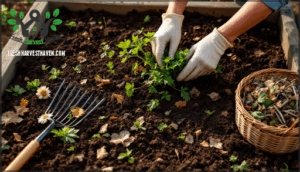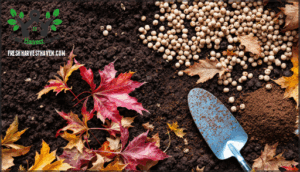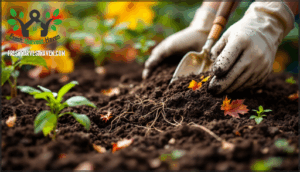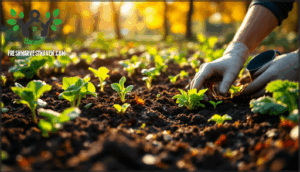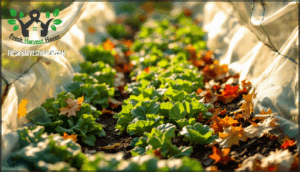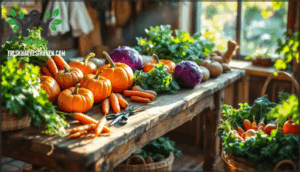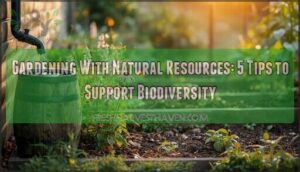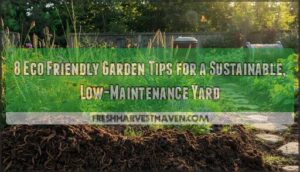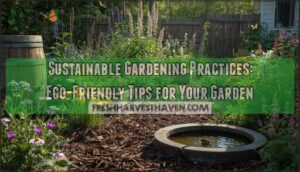This site is supported by our readers. We may earn a commission, at no cost to you, if you purchase through links.
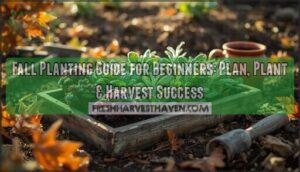
If you’ve never planted anything beyond spring tomatoes, fall gardening offers a gentler learning curve—crops are more forgiving, and you’re working with nature’s momentum instead of fighting it.
This guide walks you through the essentials: picking the right vegetables for your region, preparing beds that set plants up for success, and timing everything so you’re harvesting fresh greens well into November or beyond.
Table Of Contents
- Key Takeaways
- Planning Your Fall Vegetable Garden
- Preparing Garden Beds for Fall Planting
- Choosing and Planting Fall Vegetables
- Protecting Fall Crops From Cold and Pests
- Harvesting and Storing Your Fall Vegetables
- Frequently Asked Questions (FAQs)
- When should I start planting in the fall?
- What not to plant in the fall?
- Can I start fall gardens in containers?
- How do frost dates affect planting schedules?
- What tools are essential for fall gardening?
- Should I use row covers or tunnels?
- How often should I check soil moisture?
- Can fall crops survive unexpected early frosts?
- How do I extend growing season?
- What tools are needed for fall gardening?
- Conclusion
Key Takeaways
- Fall gardening offers a gentler learning curve than spring because cooler temperatures bring fewer pests, reduced watering needs, and more forgiving crops, while frost actually improves the flavor of many vegetables like carrots and beets.
- Successful fall planting hinges on counting backward from your first frost date, subtracting your crop’s days to maturity, and adding two extra weeks (the "fall factor") to account for slower growth caused by shorter days and cooler conditions.
- Cold-hardy vegetables like kale, spinach, and root crops thrive in fall conditions, with kale tolerating temperatures as low as 10-20°F, making them ideal choices for extending your harvest well into November or even early winter.
- Simple protective measures like row covers, mulching with 2-3 inches of organic material, and proper watering techniques can extend your growing season by weeks or months, transforming fall gardening from a short season into a reliable winter food source.
Planning Your Fall Vegetable Garden
Planning a fall vegetable garden starts with knowing your frost dates and choosing crops that can withstand cooler weather. You’ll need to time your planting carefully, counting backward from that first frost and adding a buffer for slower fall growth.
Let’s walk through the key steps to set up your fall garden for success.
Understanding Regional Frost Dates
Understanding frost dates is like having a roadmap for your fall garden—it tells you exactly when to plant and when to protect. Your average first frost date marks the point when temperatures drop to 32°F, signaling the end of your growing season. This date varies widely across zones: northern gardeners might see frost as early as August, while southern regions won’t experience it until December.
You can find your specific frost date by entering your ZIP code into online tools or checking with your local agricultural extension, which uses historical frost data spanning 30 years. Keep in mind that microclimates—like low-lying areas or urban heat islands—can shift your local frost timing by a week or more.
Climate change has also pushed many first frost dates later by over two weeks since 1970, so predicting frost requires both historical data and current trends. This data is often based on average last frost date probabilities.
Selecting The Best Fall Crops
Once you know your frost date, you’ll want to match it with the right crops. Focus on cold-hardy fall varieties like kale, which can withstand temperatures down to 10°F, or spinach, ready in just 37 to 45 days. Root vegetables such as carrots and beets sweeten after frost, while brassicas like cabbage and broccoli thrive in cool-season conditions.
For best growth, consider the benefits of cover crops to improve soil health.
Timing Planting for Maximum Yield
To get the best harvest, you’ll need to work backward from your frost date and build in a little extra time for fall’s slower pace. Start by finding your average first frost date, then subtract your crop’s days to maturity.
Add two weeks—the "fall factor"—since shorter days slow growth by up to 20%.
Check your planting window with the Fall Planting Dates Calendar, and adjust for microclimate variations that can shift timing by a week or more.
Using Planting Calendars and Tools
Once you’ve nailed down your timing, planting calendars and online tools can help you stay on track without all the guesswork. The Almanac’s Fall Planting Dates Calendar lets you plug in your ZIP code and get specific planting dates based on your average first frost.
Regional planting calendars factor in the fall factor automatically, so you’ll know exactly when to start seed starting or transplanting without doing the math yourself.
Preparing Garden Beds for Fall Planting
Getting your garden beds ready for fall planting isn’t complicated, but it does require a few important steps. Think of it as giving your soil a fresh start after summer’s heat and heavy feeding.
Let’s walk through the key tasks that’ll set your fall crops up for success.
Clearing Debris and Removing Weeds
Before you plant anything new, you’ll want to start with a clean slate—think of it as giving your garden bed a fresh haircut before the fall growing season. Here’s your weed control and soil preparation checklist:
- Pull weeds by hand or use the right tool selection for deep roots
- Remove spent plants and summer crop debris disposal from beds
- Identify perennial weeds for complete removal—roots and all
- Rake away dead leaves without excessive soil disturbance
- Sort debris for composting weeds (disease-free only) or disposal
This garden site preparation sets you up for success.
Adding Compost and Organic Matter
After clearing away debris, it’s time to feed your soil with compost and organic matter—think of it as serving your garden bed a nutritious meal before the fall planting season begins.
Here’s what to add when preparing garden soil:
| Amendment Type | Compost Benefits |
|---|---|
| Finished compost | Boosts soil microbes and nutrient cycling |
| Aged manure | Adds nitrogen for leafy greens |
| Shredded leaves | Improves soil structure slowly |
| Coffee grounds | Enriches garden soil with organic matter |
These organic amendments support soil health and improvement through natural composting methods.
Improving Drainage and Soil Structure
Good drainage isn’t just a nice-to-have—it’s what keeps your fall crops from drowning in waterlogged soil while their roots struggle to breathe. Amending clay-heavy garden soil with organic matter improves soil composition and water retention, creating drainage solutions that support soil health and improvement.
Test your soil pH and add compost or sand to fix compacted areas, preventing erosion control issues while preparing garden soil for thriving vegetables.
Choosing and Planting Fall Vegetables
Once your beds are ready, it’s time to think about what to plant and how to get those seeds or seedlings into the ground. The right varieties, proper timing, and smart planting methods will set you up for a bountiful fall harvest.
Here’s what you need to know to choose and plant your fall vegetables successfully.
Picking Cool-Season Vegetable Varieties
Your best bet? Pick vegetables that can withstand the chill. Cold-hardy options like kale tolerate temperatures as low as 20°F, while spinach and lettuce thrive in Zones 2a-11b.
Consider nutritional value—kale delivers high vitamin A, and spinach packs lutein. Disease resistance matters, too; Provider beans resist mosaic virus and mildew.
Regional favorites and yield potential help you choose fall vegetables wisely for a successful cool-season vegetable selection.
Calculating Days to Maturity
Knowing exactly when your veggies will be ready to pick isn’t guesswork—it’s just a little math that keeps you one step ahead of frost. Check your seed packet for days to maturity, then add 14 buffer days to account for cooler fall conditions—that’s your Fall Factor.
Count backward from your first frost date to find your planting deadline, and you’ll time fall planting perfectly for harvest time success.
Direct Sowing Vs. Transplanting
Some fall crops thrive when you scatter seeds right into the soil, while others need a head start indoors—and picking the wrong method can cost you weeks of growing time.
Root vegetables like carrots and radishes develop stronger root systems through direct seed sowing, avoiding transplant shock and root disturbance.
Broccoli, kale, and cabbage benefit from transplants, giving you sturdier seedlings with better vigor despite higher costs—it’s all about matching your seed starting techniques to each crop’s needs.
Succession Planting for Continuous Harvest
Instead of planting everything at once and watching your harvest window slam shut in a week, you can stagger your sowings every 10 to 14 days and keep fresh greens coming to your table well into November.
Succession planting techniques let you extend the harvest season with a continuous supply—just sow lettuce or spinach in waves, rotating crop placement each time.
These late-season sowing strategies keep your fall varieties producing steadily, maximizing what you get from your garden beds.
Protecting Fall Crops From Cold and Pests
Once your fall crops are in the ground, your job shifts to keeping them safe and thriving. Cold snaps and hungry pests can quickly undo all your hard work, but a few simple strategies make protection straightforward.
Let’s walk through the key techniques that’ll help your vegetables reach harvest, no matter what autumn throws your way.
Using Row Covers and Plant Blankets
When frost threatens your fall crops, row covers and plant blankets act like cozy sleeping bags for your garden, trapping warmth and adding important degrees of protection on chilly nights. Lightweight fabrics allow good light transmission while protecting plants from frost, and they double as pest exclusion barriers.
You’ll drape them over hoops or directly on crops, securing edges with soil or stakes for extending the growing season well into colder months.
Managing Common Fall Garden Pests
Beyond shielding your garden from cold, you’ll need to tackle pests that threaten fall crops. Cooler weather doesn’t mean bugs disappear—aphids, cabbage loopers, slugs, and cutworms actually surge as temperatures drop. These garden pests can devastate leafy greens and brassicas, but smart pest control strategies keep damage minimal:
- Hand-pick caterpillars at dusk to reduce cutworm and looper damage by up to 30%
- Encourage natural predators like lady beetles and lacewings to curb aphid populations naturally
- Apply organic controls such as Bacillus thuringiensis (B.t.) for effective insect control without chemical risks
- Remove plant debris and weeds around beds to eliminate pest harborage, cutting populations by 35%
- Use copper tape or diatomaceous earth barriers to deter slugs, reducing damage by 60%
Cultural practices work better than synthetic pesticides for disease management and maintaining beneficial insects that’ll help you next season.
Mulching to Regulate Soil Temperature
A thick blanket of mulch does more than tidy up your beds—it’s your best tool for keeping soil temperatures steady as nights turn chilly and days stay warm.
Apply 2-3 inches of straw, shredded leaves, or aged compost around your fall vegetable plantings to buffer temperature swings, lock in moisture, and knock out weeds that compete for nutrients.
Time your mulching after soil warms slightly in early fall—too early traps heat you don’t want.
Watering and Moisture Control in Cooler Weather
Don’t let cooler days fool you into thinking your garden can coast on rainfall alone—fall vegetables still need consistent moisture, just applied with a lighter touch than in summer’s heat.
Cool-season irrigation demands attention to soil moisture without overdoing it, since overwatering risks invite root rot and fungal troubles when evaporation slows.
- Check soil 2-3 inches deep before watering—if it’s moist, skip irrigation that day
- Water in morning so foliage dries before nightfall, reducing disease pressure
- Let mulch help retain moisture between waterings, cutting watering frequency while keeping roots happy
Harvesting and Storing Your Fall Vegetables
After all your careful planning and tending, it’s finally time to enjoy the fruits of your fall garden. Knowing when and how to harvest keeps your vegetables at peak flavor and nutritional value.
Let’s walk through the best practices for bringing in your cool-season crops and keeping them fresh for weeks or even months.
Recognizing Harvest Readiness
Your fall vegetables will practically tell you when they’re ready if you know what to look for. Maturity indicators vary by vegetable varieties—leafy greens like lettuce feel crisp and full-sized, while root crops like carrots develop bright color at the soil line.
Peak flavor arrives when crop growth matches the days-to-maturity listed on seed packets. Check harvesting fall vegetables regularly during garden maintenance, since best timing affects taste and extending shelf-life. Harvest signals include firm texture and vibrant color.
Techniques for Harvesting Different Crops
Each crop has its own harvesting quirks, and using the right technique keeps your produce in prime condition instead of bruised or broken. Leafy greens need clean cuts at the base to prevent wilting, while root vegetables require gentle loosening with a garden fork to avoid snapping.
Proper tool usage—sharp scissors for herbs, pruners for Brussels sprouts—makes garden maintenance tips practical and minimizes crop damage.
Harvesting vegetables carefully at peak harvest time directly impacts extending shelf life and flavor quality after post-harvest care.
Storing and Preserving Fall Produce
Proper storage transforms your fall vegetable garden bounty from a short-lived harvest into a winter food supply. Best conditions vary by crop—store apples at 32–40°F for up to a month, while winter squash prefers 45–50°F for one to three months.
Curing techniques matter: onions need 7–10 days at 80–85°F before long-term storage, dramatically extending the harvest season. Humidity control prevents shriveling in root vegetables but causes rot in onions.
Preserving methods like freezing carrots (8–12 months) or canning tomatoes follow safety guidelines to protect your hard work from harvesting vegetables through final use.
Extending The Harvest Into Early Winter
Cold frames, hoop tunnels, and row covers can push your harvest weeks or even months past the first frost, turning what seems like the end of the season into an extended growing opportunity. Cool-season vegetables like kale and spinach thrive under these frost protection strategies.
Layer row covers when temperatures drop, and you’ll keep enjoying fresh greens well into December. Winter crop choices paired with season extension methods transform fall vegetable gardening into a year-round practice.
Frequently Asked Questions (FAQs)
When should I start planting in the fall?
Start by finding your average first frost date—timing fall planting depends on this key reference point.
Count backward from that frost date, adding extra time (the fall factor) to account for slower growth in cooler temperatures and shorter days.
What not to plant in the fall?
Ironically, fall’s cool embrace welcomes many crops—but not heat-lovers.
Skip frost-tender plants like tomatoes, peppers, cucumbers, squash, bush beans, and tropical vegetables. Summer herbs, warm-season crops, and perennial flowers won’t survive.
Can I start fall gardens in containers?
Container gardening makes fall vegetable gardening accessible even without yard space. Cool-season vegetables like lettuce, spinach, and kale thrive in pots with proper container size, soil selection, and drainage needs.
How do frost dates affect planting schedules?
Frost dates work like a gardening deadline—they force you to plan backward, not forward. Your average first frost date determines when plants need to reach maturity, so you calculate your planting window by subtracting days to maturity plus the fall factor (about 14 days) from that expected frost date.
What tools are essential for fall gardening?
You’ll want soil thermometers and moisture meters for precise timing, plus pruning shears, bulb planters, and leaf collectors.
These tools simplify gardening techniques, garden maintenance, watering practices, pest control, and soil testing and nutrients.
Should I use row covers or tunnels?
Both work well for protecting your fall vegetable garden. Row covers offer lightweight pest exclusion and modest heat retention at lower cost.
Tunnels provide greater frost protection, better tunnel ventilation, and sturdier cover material—ideal when temperatures really drop.
How often should I check soil moisture?
Check soil moisture levels every two to three days in fall. Cool weather slows evaporation, reducing watering frequency factors compared to summer. Use your finger or a moisture meter to assess before irrigation.
Can fall crops survive unexpected early frosts?
Think of frost like a surprise pop quiz—it tests what you’ve prepared. Many fall crops can survive unexpected early frosts, especially hardy varieties like kale and spinach.
Frost protection methods like row covers help, and microclimate advantages near structures offer extra warmth.
How do I extend growing season?
You can stretch your harvest weeks longer using row covers, cold frames, or even a simple DIY hoop house.
These season extension techniques trap warmth, shield plants from frost, and create protective microclimates that keep greens growing well into winter.
What tools are needed for fall gardening?
You’ll need the basics—a trusty spade, rake, hose, and garden gloves for fall planting. Soil thermometers and moisture meters help fine-tune vegetable gardening conditions, while leaf blowers clear debris, pruning shears tidy beds, and bulb planters simplify your fall garden setup.
Conclusion
What if the secret to becoming a confident gardener isn’t starting in spring, but mastering fall’s forgiving rhythm first? This fall planting guide for beginners gives you everything needed to grow crisp greens, sweet root vegetables, and hardy herbs while temperatures work in your favor.
The learning curve flattens when nature’s on your side, pests retreat, and frost adds flavor instead of ending the season. Start small, plant with intention, and you’ll be harvesting long after your neighbors have closed up shop for the year.

